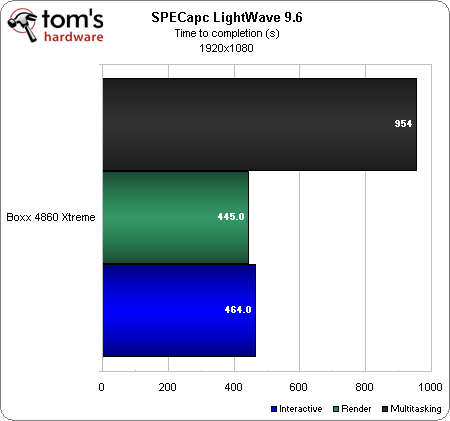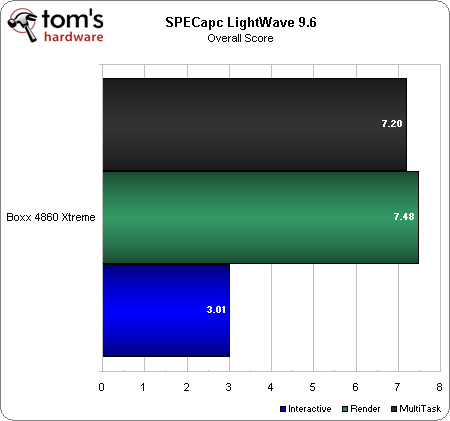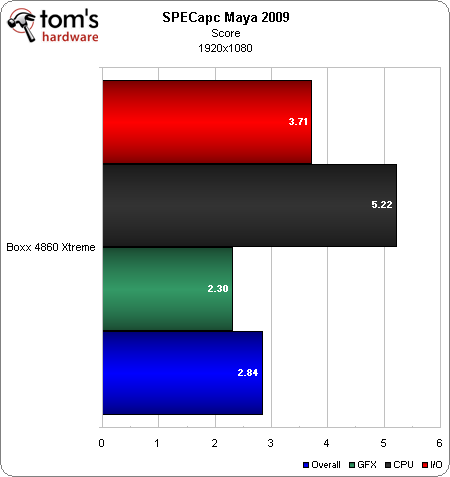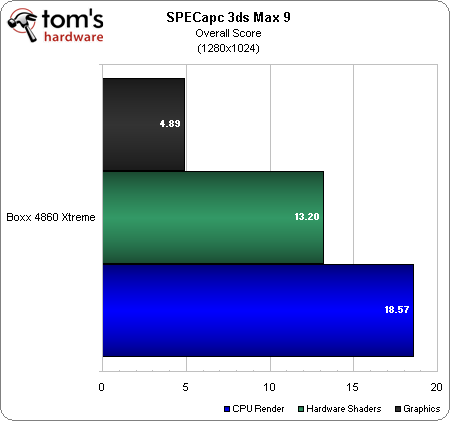Boxx Technologies 3DBOXX 4860 Workstation
Benchmark Results: SPEC Tests
The Standard Performance Evaluation Corporation was established in 1988 as a cooperative effort between workstation vendors to create a set of standardized, realistic performance tests. As it grew, it became an effort to both allow vendors to demonstrate their performance advantages and also have the tests based on existing applications, instead of older, less-relevant pieces of software.
SPECviewperf 11
Developed by the SPECgpc (Graphics Performance Characterization) working group, viewperf tests the performance of a system running under OpenGL using the graphics engines of various 3D applications from the content creation and CAD markets.
| Viewset | Composite Score | Multi-Sample Performance |
|---|---|---|
| catia-03 | 37.73 | 0x |
| ensight-04 | 39.84 | 0x |
| lightwave-01 | 41.33 | 4x |
| maya-03 | 54.90 | 0x |
| proe-05 | 10.18 | 4x |
| sw-02 | 44.24 | 4x |
| tcvis-02 | 38.00 | 0x |
| snx-01 | 37.06 | 0x |
Viewperf is designed to only stress the graphics subsystem of a computer under OpenGL. It doesn’t test CPU loading and only needs 3 GB of installed memory to run.
Most of the tests in this revision of viewperf are based on CAD-related software, with the animation software tests being LightWave and Maya. The graphics tests for LightWave and Maya are also repeated in their respective SPECapc tests. The tests marked with a multi-sample performance of 4x ran the tests with both no AA and 4x AA, while those without it ran only with no AA.
SPECapc
The SPECapc tests are application-specific benchmarks that run an extended script, which performs various operations to evaluate performance during part of a normal workflow. It tests interactivity, real-time 3D performance, and rendered 3D performance.
Get Tom's Hardware's best news and in-depth reviews, straight to your inbox.
SPECapc LightWave 9.6
The LightWave test was co-developed with Newtek and tests character animation interactivity, OpenGL performance, and software rendering. The multitasking segment of the benchmark, in which single-threaded tasks are run concurrently with rendering, helps gauge total system performance in a multitasked environment.
SPECapc LightWave performance is normalized against a 2.0 GHz Dell Precision 690 Workstation, a dual-core processor based on Intel's Core microarchitecture, with a Quadro FX 570 graphics card. So, even without other systems in the charts, you can compare the performance of this system against an older Core 2 machine at a glance.
The render time improvement of 7.48x over the baseline is particularly encouraging, but the less-impressive improvement reflected in the interactivity tests is likely indicative of some other variable.
SPECapc Maya 2009
SPECapc Maya 2009 features updates to the older Maya 6.5 workload, plus an additional scene created by AMD. Its output is also normalized against the same Dell machine as the LightWave test above. The Maya test shows a little bit less performance improvement over the baseline than the LightWave test does, likely because the Maya test is run full-screen, while the LightWave test regulates its own window size.
SPECapc 3ds Max 9
The 3ds Max 9 test is the oldest of the three SPECapc tests that we use, and is normalized against a much older machine (a NetBurst-based Xeon at 2.4 GHz using RDRAM and a Quadro 1000). Thus, while the results are easily comparable to other runs of this test, they are not easily related to the results from the other two SPECapc tests.
Consider its inclusion here to be a data marker, as SPEC is promising a new SPECapc for 3ds Max 2011 soon.
Current page: Benchmark Results: SPEC Tests
Prev Page Benchmark Results: Autodesk 3ds Max 2011, Cinebench, VUE, And MatchMover Next Page Benchmark Results: Adobe Premiere Pro, After Effects, And Photoshop-
nebun what a cheap cpu cooler they have....really...for 8k they could have installed a better cooling systemReply -
utengineer mayankleoboy1though if i were to take each component separately and build our own system, it would be cheaper.You forget, the cost of a commercial PC includes service, support, and licensed certifications.Reply
-
nforce4max I wouldn't purchase this workstation. First you can build a better base machine for the fraction of the cost. Second you can purchase on your own the software you require or pirate. Third there is a flaw, yes there is always the temptation of mounting the hard drives in that manor but isn't recommended due to the uneven wear on the spindle that can lead to early failure.Reply -
For this price, I'd go with a workstation from a major player (ex. HP or similar). You could easily build a dual socket workstation with similar (or better) overall performance; remember that many apps that require this level of hardware are optimized for Xeon instruction sets and 8+ threads. Additionally, you're software vendors would actually support their products on a system running within spec. Simply put, this is a toy not an enterprise class productReply
-
wiyosaya utengineerYou forget, the cost of a commercial PC includes service, support, and licensed certifications.Licensed certifications may be confidence inspiring to some, however, I think they are a waste of money. It is just a different form of branding that can be marketed at what is usually an expensive premium. Think THX certification. It was expensive in consumer audio and video, however, in my opinion, it has had it's 15-minutes of fame.Reply



